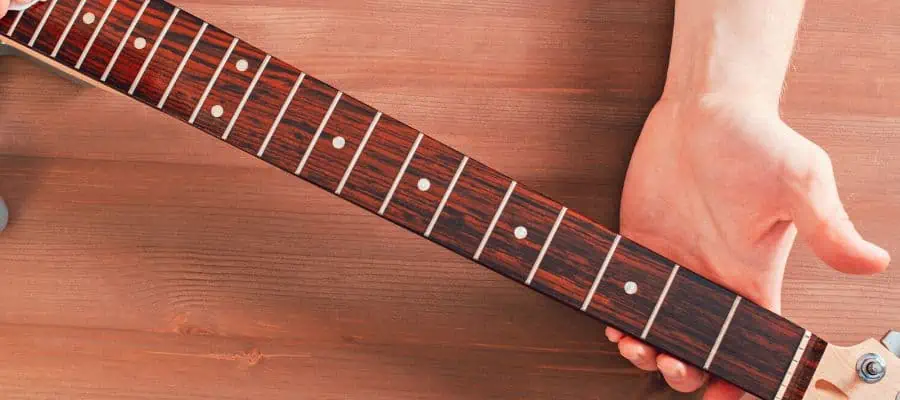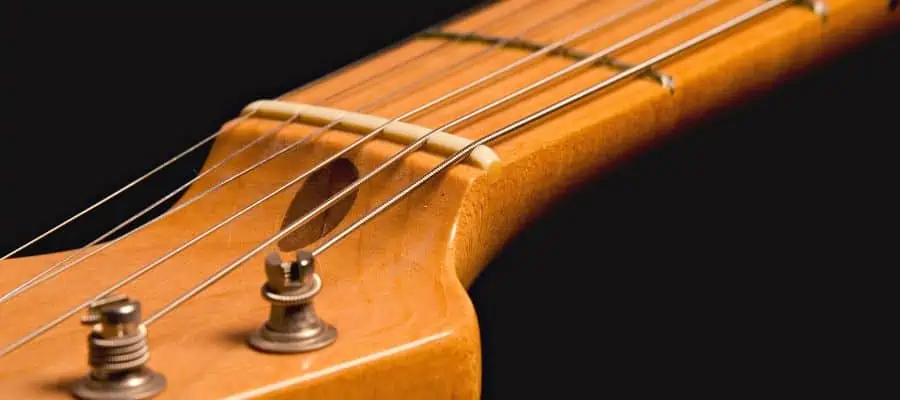Playing guitar is often a harmonious blend between engineering and art; an often overlooked crucial part is neck relief. Although it may seem straight, the subtle curvature of your guitar’s neck plays a critical role in tonal quality and playability.
High neck relief means higher action, the distance between the neck and the string on a certain fret. With too much neck relief, above 0.02” or even above 0.15” for some guitars, the guitar will suffer severe intonation and playability issues. The notes will sound sharper, and playing the instrument will feel very tiring and weird, as the high action requires more force to fret the strings.
What Is Neck Relief?

Basically, neck relief refers to how straight your neck is. It is the small amount of concave bow in a guitar’s neck that can be adjusted by the truss rod. Most often, the guitar necks are built almost straight but with the capability of a slight curve to balance the forces of string tension.
The neck relief can go two ways: concave or convex. Convex is when the neck is bent upwards to the strings, while convex is when the neck is bowed backward, away from the strings.
If the neck is too concave, it will lead to high-action and intonation issues. On the other hand, if the neck is too much on the convex side, it will lead to a fretting buzz. So, the goal here is to find the sweet spot between the two opposite sides.
How To Measure Neck Relief?

In order to adjust the neck relief of your instrument, first, you need to know how to measure the neck relief. You will need a capo and a feeler gauge for the process, and the rest is pretty straightforward.
Put the capo to the 1st fret and press the 17th fret, where the neck joins the body with one hand. Now, use the feeler gauge to measure the strings’ height on the eight-fret. The ideal height should be around 0.010 inches (0.25 mm). But be aware that the ideal height varies slightly from one guitar model to another. So, check the manufacturer’s recommendations for the ideal adjustment.
If the gauger lifts the strings, the strings are too close to the fretboard. This means your instrument needs more neck relief. If you see extra space between the feeler gauge and the strings, it means the neck is too straight or even convex. So, decreasing the neck relief would be a good idea.
How Much Guitar Neck Relief is Too Much?

While moving away from the ideal neck relief measurements is common for experienced guitar players, there are limits to respect for maintaining a playable instrument. With too much neck relief, the strings will be too far away from the fretboard, especially in the middle sections of the fretboard.
With higher action and increased neck relief, you get extra volume and clearer sound as the strings have more space to vibrate. Also, the fret buzz and choking bends issues are totally gone, leading to a cleaner sound. However, a guitar with too much neck relief will not be playable and have terrible intonation issues. The playability would feel extremely weird and tiring. Also, strings won’t be sitting evenly.
High neck relief is especially preferable for bluegrass, slide, and bottleneck players, as they need higher action. The maximum recommended neck relief for most electric guitars is around 0.02”. After that point, the intonation gets pretty challenging to adjust.
Finding The Balance

Finding the sweet spot of neck relief depends on many factors, such as playing style, string gauge, and personal preferences. Some guitarists like the neck as straight as possible without causing fret buzz, and others prefer it with more neck relief than usual.
As mentioned before, 0.010 inches (0.25 mm) is the common standard for most guitars out there. So, if you are a beginner, I recommend you stick with the manufacturer’s recommendations. With experience, you can later experiment with different adjustments and find out which works the best for you.
Every lead guitar player knows that low action is the best for quick solos. So, most guitarists like to have their necks as straight as possible without suffering from the fret buzz. This way, it is easier to press the strings, leading to more comfortable and quicker playing.
How To Adjust The Neck Relief?

Now that we know the ideal measurements of neck relief and how it affects our instrument, we can move on to start adjusting it. Even though it can be a tricky process, do not worry. If you treat your instrument carefully and avoid doing anything extreme, there is no chance of permanent damage.
The things you need are a capo, a feeler gauge or a business card, an Allen wrench, and a screwdriver for some guitars like Gibson.
- Measure your neck relief: The first thing you have to do is measure the neck current neck relief of your instrument. So, put your capo in and use your feeler gauge or a business card, which is also 0.01”, to measure the string height around the 8th fret. Depending on the outcome, you can increase or decrease the curvature.
- Acces the truss rod: it is time to get your wrench and acces the truss rod. On most guitars, the truss rod is located on the headstock next to the nut. On some guitars like Gibson, the truss rod is covered with a lid, so take your screwdriver and open the lid. However, on modern guitar the truss rod adjustment is located at the end of the neck, and it is adjusted with a small metal bar. After reaching the truss rod, put the wrench/metal bar inside and get ready to start moving the truss rod in a careful and slow motion. Never force the truss rod or try to go fast. Doing so can damage your guitar, so treat it carefully.
- Adjust the truss rod: Turning the truss rod to its right direction means less neck relief while turning it to the left means increased neck relief. Small adjustments can make big differences, so try to use the feeler gauge after every movement to check if you have reached the desired degree.
- Do regular check-ups: After the adjustment, your neck should be fine. But it won’t last forever. Changing the string gauge, humidity, tuning, and many other factors can affect neck relief. So, do regular check-ups and be aware of action or fret buzz.
Conclusion
Neck relief is a crucial factor in playability, intonation, and sound quality. Too much neck relief can lead to severe intonation problems as well as radically decreased playability. A guitar with Increased neck relief and high action is good for a more powerful, fuller, and clearer sound. Still, you should try to balance comfort, playability, intonation, and sound quality.
The standard neck relief for electric guitars is around 0.01”, while the maximum level should be 0..02”, which is already quite a lot. Of course, exact measurements depend on the guitar type, model, and player preferences. So, take the recommended numbers as references and go with the trial-error system to decide what is the best degree for you.
If you found this article useful, you may want to save this pin below to your Guitar board.

Recent Posts
Some guitarists insist on buying an expensive amplifier with their electric guitar. They assume that this is a must for every type of guitarist out there. However, in some situations, this isn’t...
Top 50 Free Realistic Guitar VST Plugins With Sound Examples
As technology has rapidly advanced in the recent decade, computers are stealing more and more roles from physical musical instruments and accessories. Nowadays, you do not need expensive amps,...

